|
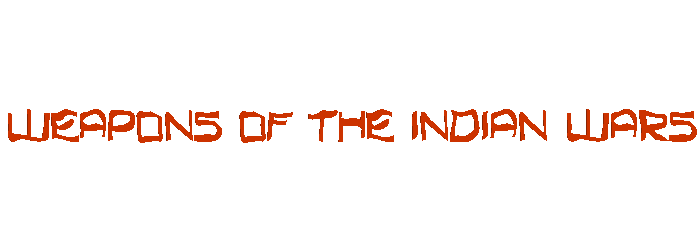
|
|
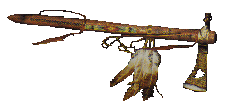
|
| Before Columbus arrived the Indians had weapons from the
stone age. He actually thought he was in India because of the description
by Marco Polo," inhabited by naked men with simpler societies than those
of the Chinese and Japanese." When the Indians and the white men traded
weapons the white men didn't know yet what they were getting themselves
into. The Indian's weapons went from stone age to a combination,
like clubs with metal fixtures attached, and then into the white man's
weapons. The white men just traded the weapons and didn't show the
natives how to use them so the Indians often lost parts of their bodies or
got cut on the sharp steel. |
|
|
| When the European explorers arrived they found the natives
hunting and fishing with proficiency and common knowledge instead of
modernized weapons. Every tribe had different ideas for hunting but
they all almost always traveled in groups. Some examples would be
how some tribes ignited areas and drove game into the water, off cliffs,
or into one area. Probably the most imaginative idea was probably
putting deer skins are their backs, then they would sneak up on their
targets and unexpectedly kill them. Most of the time they
fished. They used spears or string and hooks and used canoes in the
deeper water. |
|
|
|
Knives~
|
| The knife is the most used and wanted tool in any living
situation. The Indians got all the "trade" knives
available, which were knives mad with iron not sharpened bones or rock
chips. Indians owned many knives, just not many varieties. Fur
trading brought thousands of finished blades and full knives. Some
were pretty simple others were very intricately designed. Some were used
knives that had been cut down and sharpened, given a "new
life". |
|
|
| Indians could carry these knives safely and decoratively in
pouches called a sheath. (like the one showed at right) These were
made with leather or rawhide and sometimes a wooden liner for extra
protection. |
|
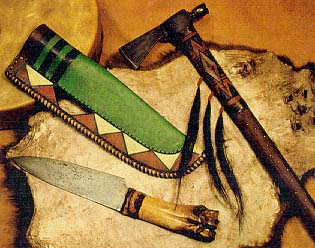
"The
knife and sheath pictured is a representation of Plains
day-to-day equipage. The heavy leather case is badly
painted not quilled or beaded, making it suitable for daily wear
as well as for hunting and forays into enemy territory. (While
some tribes wore their fanciest cloths into battle, many
reserved their finery for a triumphant homecoming and
subsequent celebrations.) A belt cutout is incorporated into the
painted design and two different types of rawhide stitching bind
together the three layers of leather. The knife has a
plain, broad blade fitted to a section of elk leg bone; the
joint covered with sinew."
|
|
| The knives were used for tools, cooking and taking
scalps. Warriors showed off the scalps they had. Sometimes the
knife they used, horses and women had captured. In some tribes you
weren't important until you got a certain number of scalps. But in
other tribes it is different. It us said, "You will never hear a crow
boast of his scalps." |
|
| "A Blackfoot dwelt rather on the number of horsed and
guns he had captured; and else where with few exceptions, the 'coup'
greatly overshadowed scalping as a deed of merit" In some
tribes the most important weapon was the coup stick. It was
sometimes said that when a man touched his enemy but didn't kill him, it
was much more of an
honor.
"Killing an enemy counts nothing unless his person is touched or
struck. ", Assiniboin. |
|
|
|
Tomahawks~ |
| The weapon that is probably most associated with the
Indians is the tomahawk. But, this weapon was greatly changed when the
white men came in. The while men decorated their custom made
tomahawks as a sort of trade mark. They were given to commemorate
treaties, seal friend ships, and as presents for important leaders.
Sometimes called a hatchet. |
|
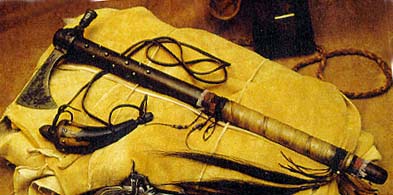
"This
tomahawk has an iron hammer polled head. The 22" long
darkly stained maple haft is studded with cones-happed
brass tacks. The grip was initially covered with a piece
of plaid cloth, then wrapped sometime later with deer skin
reinforced with linen cord. The top end of the haft
contains a metal inlay in the shape of a turtle. Of the
type possibly used by Woodland Indians or frontiersmen in the
early 1800's."
|
|
| The whites also changed what it was made of.
They rebuilt them by welding steel and brass. It was a weapon and also a
symbol of peace, it was carried like a scepter. In most photographs you
can see it with important Chiefs, it was like this for more than 200
years. The hatchet was mainly used by Native Americans like a
missile or a hand weapon. Some of the very first ones were made with sharp
stones on one or both ends, all in different shapes. When the Europeans
arrived most were then made with steel. Some tomahawks were made
with a bowl on the end to use for smoking. And the ceremonial ones were
decorated with feathers and paint. That same hatchet was buried in the
ground after reaching peace with an enemy, Many think that was the origin
of the common phrase "to bury the hatchet." |
|
|
|
Jawbone Club~ |
|
This is probably the most unusual weapon. It is made
with buffalo and horse jawbones as pretty short clubs. The teeth
were grid down and the striking area was sharpened, then it was all
decorated. |
|
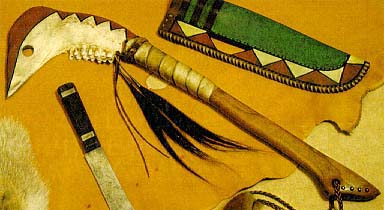
"This
war club interpretation uses a buffalo jawbone as the club
head. The 'hinge' area of the jawbone has been sharpened to a
sturdy point - powerful enough to punch through flesh or even
a man's breast bone. The round hole becomes the eye of
clubs bird-like silhouette. The simple but powerful
painted symbolism represents. to the artist, fire on the
Plains - Something with quick and deadly potential."
|
|
|
|
Gun Stock War club~ |
| This club has many different forms. Its
name started because it resembled a white man's butt of his gun. This club
also represents partial readiness, accomplishments, and authority. Hair,
carving, paint, brass tacks, hanging appendages, and feathers were often
used decorations. |
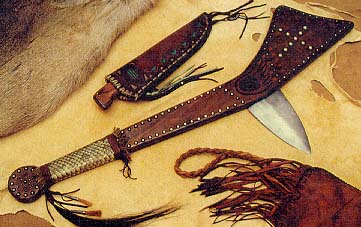
"This
gun stock war club is of a type found in areas between the
western Woodlands and the eastern Plains. It is copiously
tacked, yet not outlandish in appearance. Its brood
blade compliments the wide triangular configuration of the
wood. Snakeskin, suggesting swiftness, covers the grip;
while the painted bear paw attests to the club's ability to
cleave a pulverize."
|
|
|
|
Shield~ |
| This shield was sacred t0 the Plains
Indians. They each made it themselves and put their own magic and
good luck into them. It was a wrriors main essence as well as
obviously physical protection. |
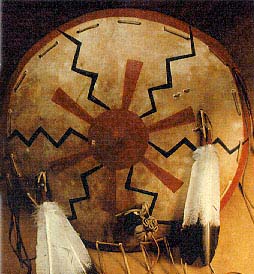
"The
shield shown is truly battle worthy in every respect. Two
layers of rawhide are stretched over a strong willow
hoop and coaxed into a convex [,curved,] shape. The grips are
not mere straps but are fully formed and reinforced arm and
hand hold, enabling a warrior to extensively carry and
maneuver this six pound shield with ease. This protection
though the application of the artist's personal sun and
lighting imagery. Two pairs of eagle (faux) feathers
fang freely, between them are a fixed two sacred objects - a
medicine bag and a bear claw."
|
|
|
|
Bow and Arrow~ |
| The most used weapon of the Indians was the traditional bow
and arrow. Still, some Indians hunted with shotguns at close range
for buffalo.
|
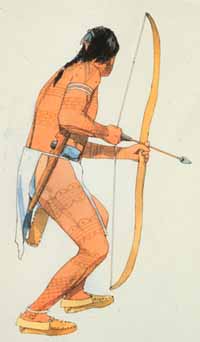 |
|
| The many wives of some of the Native men helped
decorate all the weapons. Almost all weapons were used for just that
reason. But others were decorated and kept very nice - decorated
then used as decorations. |
|
| The traded musket was almost a setback.
it could take 1,2, or more minutes to load and was so heavy that to aim
you had to carry a toll stand every where to set the musket on. The
Indians did not know how to properly use the traded weapons, they often
lost limbs or some accidents were fatal. Once the Indian started
trading the Indians got addicted to white arms, because of some of the
advantages. But with advantages there also cam disadvantages. They had to
replace gun parts every thirty to forty shots, and they were extremely
hard to find someone to replace the parts. After a while the Indians
had enough of the fire arms. They said that in the time they shoot one gun
shot they could have shot up to eight arrows, mainly in the buffalo
chases. |
|
| They Indians went though many hardships one
with their weapons. They whites came in an thought they were improving the
Indian weapons when really they were just fine as they were before.
Weapons were changing even in those days and still are. Although it
took time , patience, respect, cooperation's, and even lives. The
changing of the weapons and the world around them made the Indian
culture fade away. |
|
|
|
Lacy
Hoobler
8th
American History
Rossville
Jr. High
Plains
History Project
2004
|
Bibliography |







